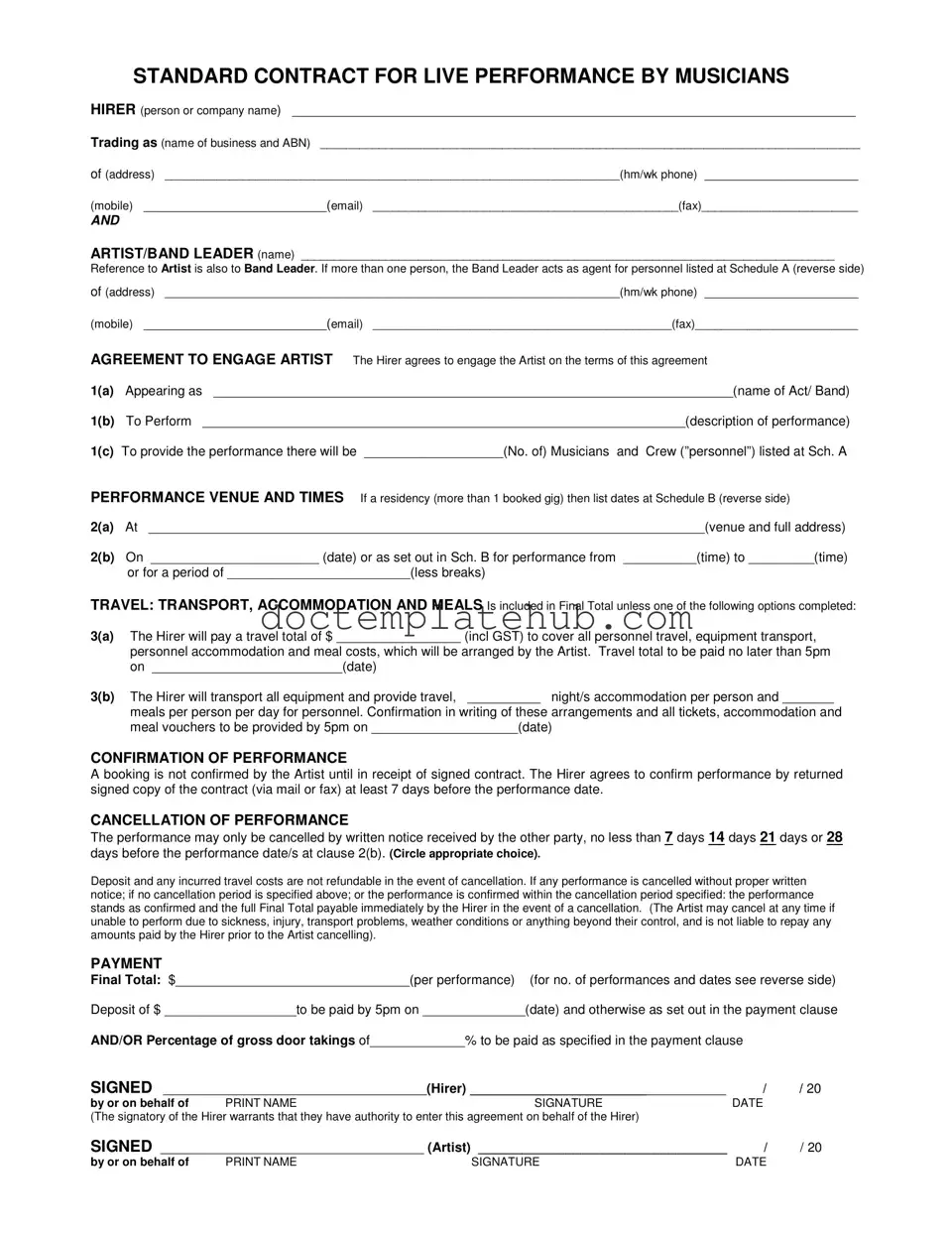The Performance Agreement is a document often used in the entertainment industry, similar to the Live Performance Contract. This agreement outlines the terms under which an artist will perform at a specific venue. It typically includes details such as the performance date, time, location, and compensation. Like the Live Performance Contract, it emphasizes the need for clear communication between the artist and the hirer, ensuring that both parties understand their responsibilities and expectations. This mutual understanding helps to prevent disputes and fosters a professional relationship.
A Booking Confirmation is another document that shares similarities with the Live Performance Contract. This document serves to confirm the details of a performance once both parties have agreed on the terms. It usually includes the date, time, venue, and payment details. The Booking Confirmation acts as a formal acknowledgment of the agreement, much like the signed Live Performance Contract, and is essential for securing the artist's commitment to the event.
An Artist Rider is a document that complements performance contracts by detailing specific requirements and requests from the artist. This may include technical needs, hospitality requests, and other logistical considerations. The Artist Rider ensures that the artist’s needs are met during the performance, similar to how the Live Performance Contract outlines the responsibilities of the hirer regarding accommodations and provisions for the artist.
Understanding the nuances of various agreements in the entertainment industry is essential, especially when it comes to protecting sensitive information. A Non-disclosure Agreement (NDA) serves as a safeguard, ensuring that all parties involved maintain confidentiality regarding proprietary details. For those seeking to create their NDA, resources like smarttemplates.net can be invaluable in providing templates and guidance.
A Venue Agreement is another document that relates closely to the Live Performance Contract. This agreement outlines the terms under which an artist or promoter can use a venue for a performance. It includes details about the venue's facilities, payment terms, and the responsibilities of both the venue owner and the artist. Like the Live Performance Contract, it aims to clarify expectations and obligations, reducing the likelihood of misunderstandings.
A Sponsorship Agreement is often used in conjunction with performance contracts, particularly for events that seek financial backing. This document outlines the terms of sponsorship, including the rights and responsibilities of both the sponsor and the artist or event organizer. Similar to the Live Performance Contract, it includes details about compensation, promotional obligations, and the duration of the sponsorship, ensuring that both parties are aligned on their commitments.
A Management Agreement is another document that bears resemblance to the Live Performance Contract. This agreement outlines the relationship between an artist and their manager, detailing the manager's responsibilities in promoting the artist and securing performance opportunities. It often includes compensation structures and the duration of the management relationship, similar to how the Live Performance Contract specifies payment terms and engagement details for performances.
A Talent Release Form is commonly used in the entertainment industry to secure the rights to use an artist's performance for promotional or commercial purposes. This document grants permission to the hirer to record and distribute the performance. Like the Live Performance Contract, it emphasizes the importance of consent and clarity in the relationship between the artist and the hirer, ensuring that both parties understand their rights regarding the use of the performance.
Finally, an Event Insurance Policy is relevant to performance contracts, including the Live Performance Contract. This document provides coverage for potential risks associated with hosting an event, such as cancellations, accidents, or property damage. It serves to protect both the hirer and the artist, similar to the indemnity clauses found in the Live Performance Contract, which outline the responsibilities of each party in case of unforeseen circumstances.
